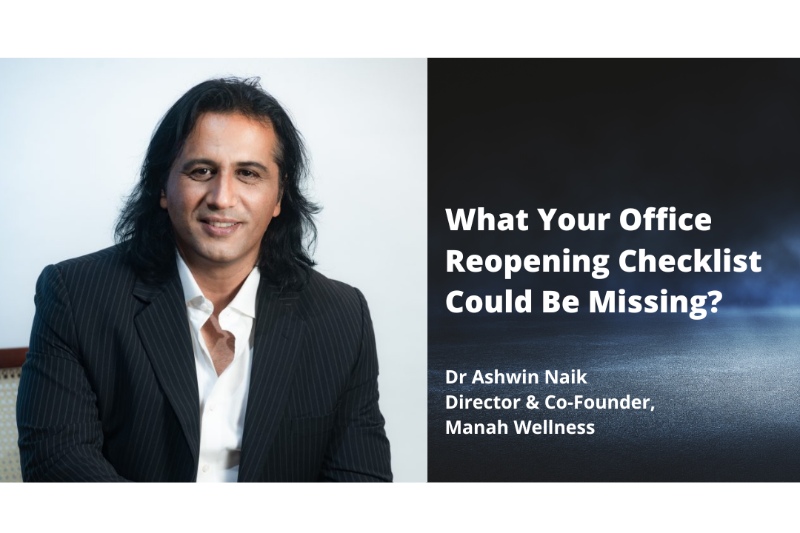Many employers have circulated return-to-work checklists on employee workgroups and emails with the usual reminders: masking, hand sanitisation & distancing. While these are all essential, your office reopening checklist could bemissing a few things.

With a healthy dose of cautious optimism, most companies seem determined to reopen their offices in 2022. However, we are not out of the woods yet as far as the coronavirus is concerned, and Omicron and ‘Delmicron’ will surely be playing on HR leaders’ minds. Many employers have circulated return-to-work checklists on employee work groups and emails with the usual reminders: masking, hand sanitisation, and distancing. While these are all essential, your office reopening checklist must address the new risks and realities we are confronted with today. Here’s what your checklist could (possibly) be missing.

A reopening council
Human resources teams are leading the back-to-office transition. However, the task of monitoring the constantly changing health and local administrative landscape and responding speedily often requires leadership involvement. This might be happening informally in many cases, but it is best to have a clear set of senior decision-makers being appointed to navigate this transition.
A leadership council or task force will be better able to coordinate and strategise the reopening process and give directions to individual teams and functions, rather than just HR teams working alone. Each council member can further take on a particular aspect of reopening – for example, one would coordinate with local government officials, while another would define safety and sanitisation protocols. A ‘Chief Wellbeing Officer’ can also be appointed to ensure that employees’ health and wellbeing are supported through this period.
Emotional check-ins
Adapting to the turbulence of the past two years has been hard already on workers. And now, the reopening of offices opens up fresh emotional challenges: the resetting of work-life balance, fears of reinfection in public transport or at work, and possibly resentment about returning to office despite being productive remotely (the last one being one of the causes of the “Big Quit” phenomenon).
Hence your checklist needs to include an emotional check-in of your staff before they start coming in. By assessing your team’s risks and coping skills across emotional parameters like lifestyle, sleep, mood, relationships, and others, you get a snapshot of where they stand on the emotional wellbeing scale. Such scientific assessments also help decision-makers figure out how to help people adapt to the in-office environment by addressing their main concerns and making the latter feel heard in the process.
Culture conversations
Workplace culture has been difficult to maintain since your colleagues became little squares and disembodied voices on conference calls. Bringing back a sense of collaboration, camaraderie and loyalty will be one of the biggest priorities for HR professionals, and therefore, it must be on your return-to-work checklist.
HR leaders need to reinitiate conversations around the culture and values that define your organisation. Such conversations must cover things like the values that bind your team, the attitudes and behaviours you want to encourage, the way your company supports people’s wellbeing, and the goals you jointly aspire to achieve. Encourage people to ask difficult questions and challenge existing assumptions: creating an environment of open-mindedness and psychological safety is paramount in these conversations.
You also need to acknowledge that the pandemic has changed notions such as work location, timings, and traditional staffing and benefits systems. Rather than quoting the rulebook every time, be willing to experiment and find out what works best for everyone.
Health initiatives
The COVID-19 pandemic was the first time a health crisis hit workplaces this hard. But it may not be the last. Workers today are extremely conscious of the necessity of a safety net for themselves and their loved ones. As an employer, you can put their minds at ease by providing or enhancing the health-related benefits you offer.
One example is enhancing your group health insurance cover or giving employees the option to widen the scope of coverage. You can also facilitate free consultations with health professionals like doctors, psychologists, or nutrition and fitness trainers. Some companies are refurbishing their office canteens to provide nutritious food options to employees at work. Steps like these increase people’s confidence about returning to work.
Training initiatives
As offices fill up, you need to address any knowledge or awareness gaps that may have arisen in the past two years. Training or retraining workshops need to be held around topics like workplace safety, mental health, soft skills, workplace diversity, digital skills, leadership skills, and other skills specific to your industry or business. Pay particular attention to newer employees to ensure that they are assimilated properly and are fully aware of what’s expected of them.
Over and above these steps, the most important office reopening guideline is to reopen slowly and with intention. Don’t rush things. If the pandemic has taught us anything, it is that patience and preparation are our best bet to stay safe against this formidable virus.
Manah Wellness on hrtech marketplace & 2021 India Marketmap.
About the Author :

Ashwin Naik is an entrepreneur and author on a mission to catalyze wellbeing and impact. As an entrepreneur he has started multiple healthcare organisations – Manah Wellness (Platform for Preventive Mental health), Let’s Talk (Helpline for Mental Health Support during COVID19), Vaatsalya (India’s first rural hospitals network), Seraniti (India’s first integrated mental health organization, acquired by Curefit) and We Scale Impact (Global Health Consulting).
He is the author of two books – The Healthcare Gamechangers, which profiles innovations around the world which have the potential to change the way healthcare is delivered, and #ChangeStartsYoung, a book about young changemakers who are starting as early as 11 years young.

